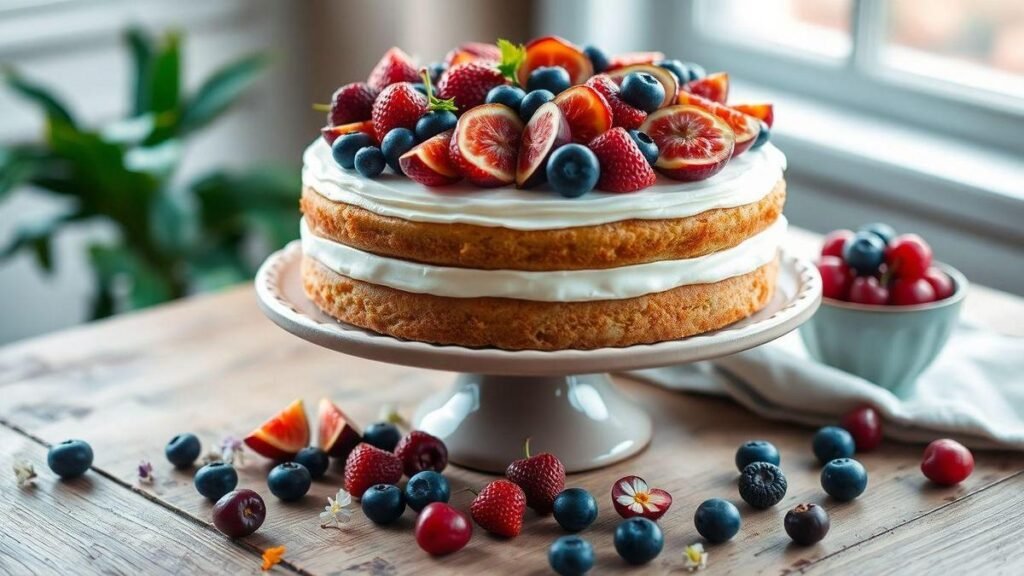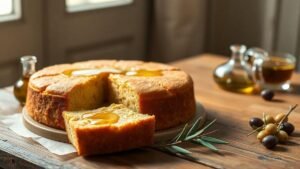I love topping cakes with fresh fruit. I get the urge for something bright and simple. In this article I show how to use fruit as a natural cake topping, which fruits work best, how to prepare fruit, and a quick fruit glaze that helps prevent browning and keeps pieces in place. Top it fresh. Keep it simple. Let the fruit shine.
- Fresh fruit gives cakes natural color, sweetness, and texture
- Best choices: berries, peaches, kiwi, citrus — they look and taste lovely
- Slice and pat dry, then use a quick glaze to prevent browning and hold pieces (see tips to add fruit to a cake without making it soggy)
- Keep designs simple so the fruit can shine without heavy frosting
- Chill cakes and add delicate fruit just before serving to keep it fresh
How to Use Fruit as a Natural Cake Topping: Fresh, Beautiful, and Delicious
I love topping cakes with fresh fruit — it brightens a cake like sunshine after rain. Fruit adds color, sweetness, and texture. Below you’ll find the best fruits, how to prep them, a simple glaze, design ideas, safety tips, and storage. I keep steps short. Let the fruit be the star. If you prefer a cake that shows off flavor without heavy icing, consider techniques from cakes that don’t need frosting.
Why Top Cakes with Fruit?
- Fruit makes a cake look fresh and pretty
- It adds natural flavor without heavy frosting
- Fruit can make a cake feel lighter and more wholesome
- Quick fix: fruit hides small defects, like a slightly dry crumb — a good rescue technique when your cake needs a lifeline (see ideas for saving a dry cake)
I once saved a cake by piling berries on top — guests loved it. A pile of fruit can save the day.
Best Fruits for Cake Topping
| Fruit | Why I Like It | How I Use It |
|---|---|---|
| Strawberries | Bright, sweet, easy to slice | Halved or sliced, fanned |
| Blueberries | Small, pop of color | Scatter whole |
| Raspberries | Tart and pretty | Place in rings or clusters |
| Blackberries | Deep color, juicy | Cluster or line the edge |
| Kiwi | Green contrast, tropical kick | Thin rounds |
| Peaches / Nectarines | Sweet, soft, juicy | Thin slices or wedges |
| Mango | Rich, tropical sweet | Thin slices or ribbons |
| Figs | Earthy, elegant | Halves or quarters |
| Pomegranate seeds | Sparkling crunch | Sprinkle for texture |
| Citrus (orange, clementine) | Bright flavor, color | Segment or thin rounds — for lemon-forward cakes, try pairing with a bright lemon cake |
How to Prepare Fruit for Cake
| Step | What I Do | Tip |
|---|---|---|
| Wash | Rinse gently in cold water | Dry on paper towel to avoid a soggy cake |
| Hull / Peel | Remove stems and peels as needed | Use a sharp knife for clean cuts |
| Slice | Cut even slices or wedges | Thin slices lay flat and look neat |
| Pat dry | Remove extra juice | Keeps cake from getting soggy (more on how to prevent sogginess) |
| Chill | Keep fruit cold until assembly | Cold fruit looks fresher longer |
Quick Prep Tricks
- For soft fruit, slice just before topping.
- For berries, dry them well to stop juice from bleeding.
- For citrus, remove pith for a clean look.
- If using frozen fruit as a backup, learn how to work with frozen fruit in cakes so you still get great results.
Optional Glaze for Shine and Freshness
A glaze does two jobs: it gives shine and helps keep fruit from drying or browning.
| Glaze Type | Ingredients | How I Use It |
|---|---|---|
| Apricot jam glaze | Apricot jam water | Heat until runny, strain if chunky, brush on warm fruit |
| Neutral glaze | Gelatin water sugar | Brush lightly for hold and shine |
| Honey glaze | Honey splash of lemon | Thin with warm water, brush on |
| Simple syrup | Sugar water | Brush for shine and light sweetness |
Quick Fruit Glaze:
- Heat 1/4 cup apricot jam with 1 tbsp water. Strain if chunky. Brush on fruit while warm. This holds berries in place and helps stop browning.
Design Ideas with Fruit Toppings
| Look | How I Build It | Best Fruit |
|---|---|---|
| Rustic heap | Heap mixed fruit in center | Berries, figs, stone fruit |
| Ring of fruit | Place slices around edge | Kiwi, strawberries, peaches |
| Single fruit pattern | Rows or concentric circles | Blueberries, raspberries |
| Minimalist | Few large slices | Figs, mango, peaches |
| Drip fruit | Add a drip edge then fruit | Chocolate drip with berries |
If you want easy, beautiful finishes without fancy tools, check techniques for decorating without piping bags and tips to make a cake look professional at home in simple, professional steps.
I like the heap — it’s forgiving and looks like a garden. A ring looks neat and classic. Pick a style that suits your mood.
Cakes That Pair Perfectly with Fresh Fruit
| Cake | Fruit Pairing | Why It Works |
|---|---|---|
| Vanilla sponge | Mixed berries | Light cake, bright fruit — build layers even without a stand mixer (see how to make a layer cake without a mixer) |
| Lemon cake | Blueberries, raspberries | Tart meets sweet — try a recipe for a lemon cake made with real juice |
| Chocolate cake | Strawberries, raspberries | Bitter-sweet match |
| Almond cake | Figs, pears | Nutty and soft fruit |
| Yogurt or ricotta cake | Stone fruit, berries | Creamy and bright — see tips for a soft cake using yogurt |
A sponge with berries feels fresh and easy. Chocolate and strawberries is a classic for good reason.
Tips for Using Fruit Safely
| Risk | Tip |
|---|---|
| Pesticides | Wash fruit well under cold water |
| Allergies | Ask guests about fruit allergies |
| Mold | Use firm, ripe fruit—discard bruised pieces |
| Cross-contamination | Use clean knives and boards |
| Overripe fruit | Taste a bit first; toss if fermented |
I always check fruit for soft spots. If it smells off, I throw it out — better safe than sorry. For practical handling and to avoid soggy results, see advice on preventing juice bleed and sogginess.
Storage
| Item | Fridge | Freeze | Best Practice |
|---|---|---|---|
| Topped cake | 1–2 days | Not ideal | Store in a cake box, cool fridge |
| Fresh fruit (unwashed) | 3–7 days (varies) | Yes (berries best frozen) | Keep in a single layer if possible |
| Glazed cake | 2–3 days | Not recommended | Glaze helps keep fruit fresh longer |
| Sliced fruit | 1–2 days | Freeze for smoothies | Use airtight container, minimize air |
If you need longer storage, freeze cake layers without fruit, then add fresh fruit when serving — or learn how to work with frozen fruit in cakes. For outdoor events, packing tips from picnic-friendly cake guides can help keep fruit-topped cakes looking great.
A Naturally Beautiful Finish
Keep things simple. A few bright berries or a ring of sliced peaches can make a cake sing. Use glaze when you want shine, store cakes cool, and eat them within 24–48 hours for peak freshness. Top fruit right before serving for the best look and flavor.
Leave a Comment
Fields:
- Comment — Your email address will not be published. Required fields are marked.
- Name
- Website
- Checkbox: Save my details in this browser for next time I comment.
Last Posts
- I Saved My Sunken Cake
- I Finally Made Glossy Chocolate Ganache
- I Tried a Simple Cake Glaze
- I Swear Yogurt Saved My Dry Cake
Conclusion
A few simple choices turn a cake from good to wow. Use fresh fruit for instant color, texture, and real flavor—no heavy fuss needed. Pick firm, ripe pieces, wash and pat dry, and keep them chilled until the last minute. A light glaze (apricot jam or simple syrup) gives shine and helps prevent browning. Slice thin for balance and add delicate pieces right before serving. Store finished cakes cool and eat within 24–48 hours.
Let the fruit sing. It’s an easy trick that often saves the day. For more tips and recipes, visit https://xendrie.com.
Frequently Asked Questions
- What fruits work best to top a cake?
Berries, stone fruits, kiwi, and citrus shine. Pick firm, ripe, and not-too-watery fruits.
- How do I prepare fruit for a cake?
Wash and dry well. Slice or halve, remove seeds as needed, and chill before placing.
- How do I keep fruit shiny and from browning?
Brush a quick fruit glaze over the fruit, or toss apple/banana slices in a little lemon juice.
- How should I arrange fruit for a pretty cake?
Keep it simple: a central pile, a neat ring, or overlapping slices. Let the fruit be the star.
- How long will a fruit-topped cake stay fresh?
Refrigerate and cover gently. Best eaten within 24–48 hours to avoid sogginess and spoilage.






